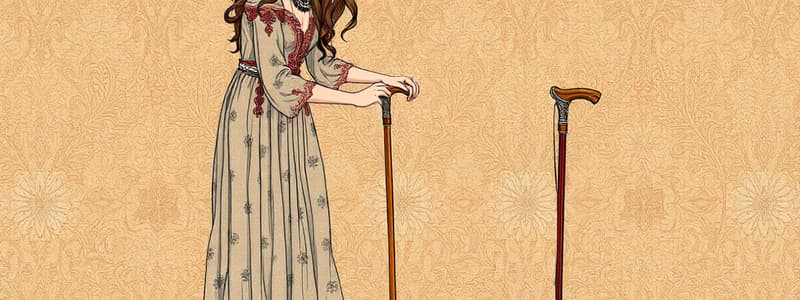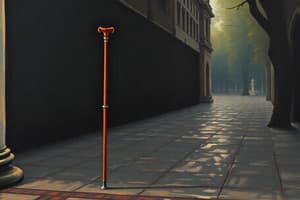Podcast
Questions and Answers
What is a primary advantage of using canes?
What is a primary advantage of using canes?
- They eliminate the need for physical therapy.
- They can reduce weight from an affected lower limb when used properly. (correct)
- They are the most stable mobility aid available.
- They can support a full body weight without assistance.
Which statement describes a disadvantage of using canes?
Which statement describes a disadvantage of using canes?
- They are ineffective for individuals with balance issues.
- They provide excellent support compared to walkers.
- They have a higher risk of slippage compared to other mobility aids. (correct)
- They require more upper body strength than crutches.
Which type of cane offers a more comfortable handgrip and improved support?
Which type of cane offers a more comfortable handgrip and improved support?
- Standard Cane
- Offset Cane (correct)
- Quadripod Cane
- Medical Cane
What feature distinguishes a quadripod cane from other types of canes?
What feature distinguishes a quadripod cane from other types of canes?
What is a potential drawback of the standard cane's design?
What is a potential drawback of the standard cane's design?
What is the primary purpose of mobility assistive devices?
What is the primary purpose of mobility assistive devices?
What is a significant disadvantage of using a cane?
What is a significant disadvantage of using a cane?
Which type of mobility assistive device requires the user to bear some weight on their legs?
Which type of mobility assistive device requires the user to bear some weight on their legs?
Which of the following is NOT a common type of mobility assistive device?
Which of the following is NOT a common type of mobility assistive device?
What is an essential precaution when using crutches?
What is an essential precaution when using crutches?
Flashcards
Assistive Devices
Assistive Devices
Tools used to help people with disabilities or limitations perform daily tasks.
Mobility Assistive Devices
Mobility Assistive Devices
Devices that help people move around, walk or maintain balance.
Cane/Stick
Cane/Stick
A long, single-support assistive device used as walking aid, improving stability and balance.
Crutches
Crutches
Signup and view all the flashcards
Walker/Rolator
Walker/Rolator
Signup and view all the flashcards
Cane advantages
Cane advantages
Signup and view all the flashcards
Cane disadvantages
Cane disadvantages
Signup and view all the flashcards
Standard cane
Standard cane
Signup and view all the flashcards
Offset cane
Offset cane
Signup and view all the flashcards
Quadripod cane
Quadripod cane
Signup and view all the flashcards
Study Notes
Outline
- Introduction
- Definition of assistive devices
- Function of assistive Devices
- Types of Assistive Devices
- Mobility assistive devices
- Definition
- Factors affecting selection of the type of assistive device
- Degree and description for weight-bearing status
- Most common types of mobility assistive devices include:
- Canes/sticks
- Advantages of canes
- Disadvantages of canes
- Styles of canes
- How to use a Cane
- Precautions when using canes
- Crutches
- Description of crutches
- Types of crutches
- How to use crutches
- Precautions when using crutches
- Walker/rolator
- Types of walkers
- How to use walkers
- Precautions when using a walker
- Canes/sticks
- Mobility assistive devices
Studying That Suits You
Use AI to generate personalized quizzes and flashcards to suit your learning preferences.




